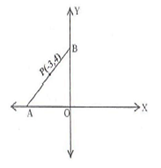The slope of a line joining P ( 6, k ) and Q (1- 3k, 3 ) is . Find
(i) k
(ii) Midpoint of PQ, using the value of ‘k’ found in (i).
( ii ) Substituting k in p and Q, we get
P ( 6, K ) = P ( 6, - 11 ) and
Q ( 1 - 3 k, 3 ) = Q ( 1 - 3 ( - 11 ), 3 ) = Q ( 1 + 33, 3 ) = Q ( 34, 3 )
Calculate the ratio in which the line joining A( - 4, 2) and B(3, 6) is divided by a
point P(x, 3). Also find
(i) x
(ii) Length of AP.
(i) Given points are A(- 4, 2) and B(3, 6)
Let P(x, 3) divides the line joining A(- 4,2) and B(3,6) in the ratio k :1.
Thus, we have
...(i)
And
6k + 2 = 3(k + 1)
6k + 2 = 3k + 3
3k = 1
By substituting the value of k in equation(i), we have
Thus, coordinates of P are
(ii) Now, the distance AP =
=
=
=
=
AP = units
ABC is a triangle and G(4, 3) is the centroid of the triangle. If A = (1, 3), B = (4, b) and C = (a, 1), find ‘a’ and ‘b’. Find length of side BC.
Given,
The coordinates of the vertices of ABC are A(1, 3), B(4, b) and C(a, 1).
The coordinates of the centroid are G(4, 3).
It is known that A(x1, y1), B(x2, y2) and C(x3, y3) are vertices of a triangle, then
Thus, the coordinates of the centroid of ABC are ()
the coordinates of the centroid of ABC are () = ()
But, as given the coordinates of the centroid are G(4, 3).
Thus, we have
Thus, the coordinates of B and C are (4, 5) and (7, 1) respectively.
Using distance formula, we have
BC =
=
=
= 5 units.
Thus, the length of BC is 5 units.
P(1, -2) is a point on the line segment A(3, -6) and B(x, y) such that AP : PB is equal to 2 : 3. Find the coordinates of B

Given, P ( 1, - 2 ), A ( 3, - 6 ) and B ( x, y )
AP : PB = 2 : 3
But, the co-ordinates of P are ( 1, - 2 ).
Hence, the co-ordinates of B are ( - 2, 4 ).
In the figure given below, the line segment AB meets X-axis at A and Y-axis at B. The point P(-3, 4) on AB divides it in the ratio 2:3. Find the coordinates of A and B.

a) Let the coordinates of A and B be (x, 0) and (0, y) respectively.
Given P divides AB is the ratio 2:3,
Using bisection formula, we have
Thus, the coordinates of A and B are (–5, 0) and (0, 10) respectively.
